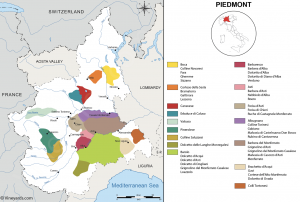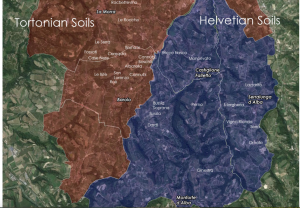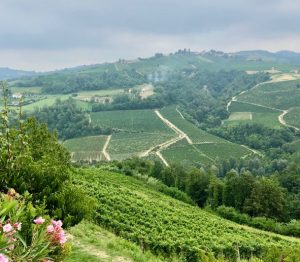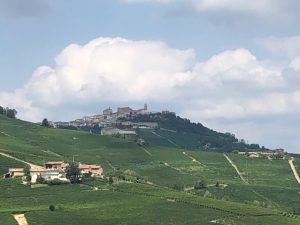Reaching from close to the Matterhorn in Switzerland almost to the Mediterranean, Piemonte (Piedmont) covers a lot of territory. The region lies east of the border with France and west of Milan, taking up a large portion of northwest Italy. Known in the wine world for its powerhouse duo of Barolo and Barbaresco, and on the culinary front for white truffles from Alba and gianduja chocolate from Torino, it rules the roost on a few fronts. Throw in the most important automobile museum in Italy and a Bicerin at the caffe – the heavenly mix of coffee, chocolate and whipped cream – well, Piemonte should be on everyone’s “must visit’ list.
The region ranks 6th in wine production, but first in quality with the most DOCG denominations of any wine region in Italy. With more than 20 different native grape varieties and a variety of unique terroirs, Piemonte wins many of the top wine awards, year after year. While red wine is king here – over 60% of production, white wines are also attracting some serious attention. In fact, Moscato Bianco, used to produce Asti Spumante, the world’s most popular sweet sparkling wine, accounts for 21% of grape plantings. While grape are cultivated over most of the province, most of the vineyards are concentrated in the southern and eastern parts, near the cities of Alba and Asti.

The hills of the Langhe and Monferrato have some of the most intensely planted vineyard areas in the country. Barolo is mapped with almost the precision of Burgundy, with different vineyards, parcels and zones organized by the Consorzio as MGA or menzioni geografiche aggiuntive, in order to regulate the use of the names historically known to produce wines of distinction.
Nebbiolo, Barbera and Dolcetto are the most well-known red grape varieties. Barbera has been grown in the area since the 18th century and Dolcetto has its earliest mention in the 16th century. Nebbiolo, considered to be the noble red grape, is the oldest was first mentioned in documents here in the 13th century. Freisa, Grignolino, Ruche, Pelaverga Piccolo and Brachetto are also native or traditional varieties. For the whites, Moscato Bianco, Cortese, Arneis, Erbaluce and Timorasso have all been here for centuries. Nascetta and Favorita (Vermentino) have small plantings but are worth seeking out.
Piemonte can be divided really into four parts. The northern wine growing region above Torino borders Valle D’Aosta on the west, Lombardia on the east and Switzerland on the north. The primary wines here are Nebbiolo and Erbaluce. It is referred to as the Alta Piemonte and is home to the Novara and Vercelli hills near the border with Lombardia. The prestigious appellations of Gattinara and Ghemme are located here. Western Piemonte and the Torino hills is the smallest and least productive zone. The focus is on local grapes rarely seen outside the area like Uva Rara, Pelaverga Grosso, Chatus, Avana, Neretta Cuneese and Doux d’Henry.
To the south, lie the hills of the Langhe and Roero in the Alba subregion – arguably one of the most well-known wine areas in all of Italy. Separated by the Tanaro River, the Langhe is on the right bank to the south and the Roero hills on the left bank to the north. Alba itself, of great historic, gastronomic and economic importance to the region, lies between the two but is considered to be a part of the Langhe.
The area is practically carpeted in vineyards, covering the gentle hills crowned by medieval hamlets. Nebbiolo, Barbera and Dolcetto are the classic grapes, grown in the 12 appellations. The hilly area of Monferrato centers around the towns of Asti and Alessandria in the southeastern section of Piemonte. Together with Langhe and Roero, this area was listed as a UNESCO World Heritage Site due to the landscape and the interwoven connection between the vine and the people. The production is Barbera, Ruche, Brachetto, Freisa, Dolcetto and Grignolino for the red grapes and Moscato Bianco for the white.
Barolo and Barbaresco, both made with Nebbiolo, are on opposite sides of the town of Alba. Called the “King of Wines and the Wine of Kings”, Barolo must be produced from 100% Nebbiolo and can only be produced in 11 comunes, the most significant being Barolo, La Morra, Serralunga d’Alba, Monforte d’Alba and Castiglione Falleto. Within this area, the soils are defined by two geological formations which greatly influence the character and longevity of the wines. In the west are found the soils of the Tortonian era, a calcareous marl that is more compact and fertile, around the towns of Barolo and La Morra. It produces wines that tend to mature more rapidly – they are softer, rounder, more perfumed and fruity.
In contrast, the soils to the east are Helvetian/Sarravallian, composed mainly ofrRed sandstone and quartziferous sand. This produces wines that are more structured, with firmer tannins, more power and fuller in body. While these wines are exceptionally long-lived, they require much more bottle ageing time to reach their potential and become more approachable. As Nebbiolo, much like Pinot Noir, is very site specific, single vineyard bottlings have developed considerably since the 1970s from the best sites.
Historically, these places were those in which the snow melted first, sunny places higher on the hills. In fact, these sites are named as Bricco, a superior site on the higher part of the hill and Sori, a sunny and well-exposed site. These areas made the difference in the optimum ripening of Nebbiolo. Barolo, by the DOCG requirements, must be aged for a minimum of 38 months, with at least 18 months in oak. The Riserva must be aged for 62 months, also with a minimum of 18 months in oak.
The color is a light ruby, with complex aromas of rose and violet, cherries, fresh red berries, tar and forest floor. With high tannins and acidity, it ages and evolves to produce dried fruit and flower aromas, with spices, leather, tobacco, licorice and some gamey notes. Buy these for the cellar!

The soil map of Barolo Map Photo by Tenzing Wine & Spirits
Barbaresco can be called the queen to Barolo’s king. Located on the right bank of the Tanaro River, the soils are predominately Tortonian, with layers of sand. With a slightly warmer climate than Barolo, the grape tend to mature earlier than in Barolo. Here, in the communes of Barbaresco, Neive and Treiso, the plantings are mainly mid-slope with south-facing vineyards. While factors like soils, altitudes and exposures are similar, the area is more consistent so the differences between vineyard sites tend to be less pronounced. The denomination however began using the MGA (additional geographic designation) in 2007, prior to Barolo, to designate the specific sites or vineyard names.
In the past, Barbaresco was deemed to be lighter in style and less structured than Barolo – a more feminine wine. Today, many rival the power and structure of their neighbor. In fact, prior to the 1890s, the grapes from Barbaresco were mainly used to make Barolo. But in the 1960s, Angelo Gaja began to show its real potential and turned it from one with a local reputation to a world class wine – today bottles sell for hundreds of dollars. The regulations call for minimum aging of 26 months, with 9 months in oak and 50 months for the Riserva.


Barolo and its vineyards Photo by Vinotalia Vineyards in Barbaresco Photo by Vinotalia
